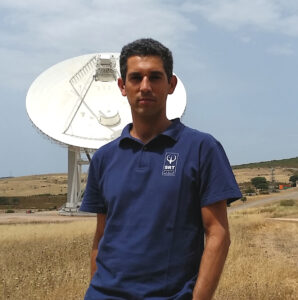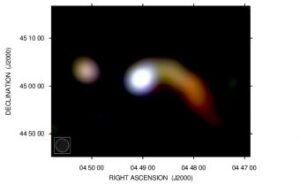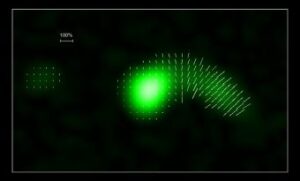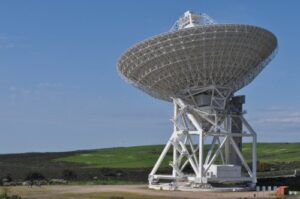The Sardinia Radio Telescope (SRT) kicks off its scientific programs with a bang!
The first scientific article based on data collected by its 64-meter diameter dish and cutting-edge instrumentation has just been published in the Monthly Notices of the Royal Astronomical Society. The SRT observations, led by a team of INAF scientists with contributions from researchers at the University of Cagliari, focused on a supermassive black hole: a novel radio image shows this object speeding towards the center of a distant galaxy cluster known as 3C129.
The black hole dominates the core of an elliptical galaxy about 300 million light-years from Earth. The pair is on a “collision course” with a nearby galaxy cluster, pulled by the gravitational force generated by the massive concentration of dark matter, galaxies, and hot gas. Radio images reveal that the black hole is actively accreting matter from the surrounding medium. Some of this material doesn’t fall into the black hole but is expelled along two plasma jets, forming a spectacular radio trail much longer and more extensive than the galaxy itself.
 “The phenomenon is somewhat similar to the contrails produced by airplanes,” explains Matteo Murgia, an INAF researcher at the Astronomical Observatory of Cagliari and the study’s lead author. “In the case of jets associated with the black hole, the ‘unburned fuel’ consists of magnetic fields and high-energy electrons that cool by emitting radio waves. By comparing the new images obtained by SRT with those from other radio telescopes, we have, for the first time, created an age map of this radio source, concluding that the black hole is moving through space at a supersonic speed.” On Earth’s surface, the speed of sound is 1,200 km/h, while in the atmosphere of the galaxy cluster surrounding the black hole, an ultra-rarefied gas at a temperature of tens of millions of degrees Kelvin, the speed of sound is 4 million km/h. The black hole exceeds this speed limit by 1.5 times.
“The phenomenon is somewhat similar to the contrails produced by airplanes,” explains Matteo Murgia, an INAF researcher at the Astronomical Observatory of Cagliari and the study’s lead author. “In the case of jets associated with the black hole, the ‘unburned fuel’ consists of magnetic fields and high-energy electrons that cool by emitting radio waves. By comparing the new images obtained by SRT with those from other radio telescopes, we have, for the first time, created an age map of this radio source, concluding that the black hole is moving through space at a supersonic speed.” On Earth’s surface, the speed of sound is 1,200 km/h, while in the atmosphere of the galaxy cluster surrounding the black hole, an ultra-rarefied gas at a temperature of tens of millions of degrees Kelvin, the speed of sound is 4 million km/h. The black hole exceeds this speed limit by 1.5 times.

Multicolor composition of 3C129 obtained from a combination of three radio band exposures: 0.3 GHz (Westerbork Synthesis Radio Telescope; red), 1.4 GHz (Very Large Array; green), and 6.6 GHz (SRT; blue). Note how the color tone gradually changes from blue to reddish due to the intense radiative cooling of the emitting radio plasma.
“Another peculiarity of this black hole,” Matteo continues, “is the presence, in front of the galaxy, of a shock front similar to that preceding a supersonic military jet. To our surprise, we found that the speed we measured is exactly what was previously theorized to justify the presence of the shock wave.”
Thanks to SRT, it’s also possible to observe the radio sky in polarized light. The degree of polarization of a radio wave is an important source of information for astronomers: it can indicate the strength and orientation of astrophysical magnetic fields. Near the black hole, the plasma flow is turbulent and chaotic, but along the trail, the plasma flow becomes more regular, and the level of polarization gradually increases, revealing highly ordered magnetic fields.
 Image of 3C129 in polarized light obtained with SRT at 6.6 GHz. The length of the white segments is proportional to the percentage of polarization, while their orientation represents the polarization angle of the radio waves.
Image of 3C129 in polarized light obtained with SRT at 6.6 GHz. The length of the white segments is proportional to the percentage of polarization, while their orientation represents the polarization angle of the radio waves.
“This study marks the first publication of a scientific result for SRT,” states Ettore Carretti, current head of SRT and co-author of the work. “It demonstrates that SRT is ready to produce high-quality images of the radio sky, even in polarization, which is usually the last and most challenging step in the setup of a new instrument. This is a clear indication of the maturity reached by the radio telescope’s performance, which is now ready to deliver the cutting-edge science it was built for.”
“SRT is among the largest and most sensitive radio telescopes in the world, and it’s exciting to see how these first results confirm its scientific performance. This is just the first of many new discoveries we expect to come from this telescope,” declares Steven Tingay, head of the Radio Astronomy Science Unit of the INAF Scientific Directorate.
“The high quality of this result,” emphasizes Andrea Possenti, Director of the Astronomical Observatory of Cagliari, “is the first extraordinary culmination of a project strongly desired in 2011 by the Autonomous Region of Sardinia, which issued a three-year “Tender” aimed at developing “Radio Astronomy and related technologies” on the island. Today we see the fruits of that choice: with those funds, a data acquisition system among the most advanced in the world was designed and built at the INAF-Cagliari Observatory laboratories, aptly named SARDARA (SArdinia Roach2-based Digital Architecture for Radio Astronomy), to highlight the role played by the Sardinia Region.”
“In addition to enhancing the potential of the Sardinia Radio Telescope,” Possenti continues, “the development of SARDARA has provided a unique opportunity to promote the growth of knowledge in Sardinia in the fields of digital electronics, computer science, and programming. A magnificent confirmation that investments in basic research have significant impacts on the territory.”
“SARDARA,” conclude Andrea Melis and Raimondo Concu, OAC technologists and responsible for the system’s implementation, “represents a breakthrough in the landscape of acquisition systems: it is an entirely reconfigurable instrument thanks to the FPGA boards it is equipped with, and it can be adapted to all possible scientific applications of SRT: continuum, spectroscopy, spectropolarimetry, pulsar, fast radio burst, search for extraterrestrial life signals, space debris, interplanetary probe tracking, and more.”
In short, the first step towards a future full of exciting discoveries!
To learn more:
The scientific article Sardinia Radio Telescope wide-band spectral-polarimetric observations of the galaxy cluster 3C 129 by M. Murgia, F. Govoni, E. Carretti, A. Melis, R. Concu, A. Trois, F. Loi, V. Vacca, A. Tarchi, P. Castangia, A. Possenti, A. Bocchinu, M. Burgay, S. Casu, A. Pellizzoni, T. Pisanu, A. Poddighe, S. Poppi, N. D’Amico, M. Bachetti, A. Corongiu, E. Egron, N. Iacolina, A. Ladu, P. Marongiu, C. Migoni, D. Perrodin, M. Pilia, G. Valente, and G. Vargiu is being published in the Monthly Notices of the Royal Astronomical Society.
 SRT is a brand-new 64-meter diameter radio telescope located 35 km north of Cagliari. SRT is funded by the Ministry of Education, University and Research, the Italian Space Agency, and the Autonomous Region of Sardinia, and is operated by the National Institute for Astrophysics. The telescope can efficiently operate in the radio frequency range from 0.3 to 116 GHz, thanks to its innovative active surface: the primary mirror is not a single surface but is composed of 1008 panels that are digitally controlled through actuators to compensate for gravitational deformations of the structure and to modify the shape of the antenna depending on the focal position used. A technologically advanced system that only a few radio telescopes in the world possess, allowing SRT to achieve high-quality performance, especially at higher frequencies. The antenna was officially inaugurated in 2013 upon completion of the technical commissioning. This was followed by an Astronomical Validation phase that transformed the telescope from a powerful technological tool into a true observatory for studying radio waves. In February 2016, SRT was opened to the scientific community in so-called shared-risk mode for an initial series of so-called Early Science Programs.
SRT is a brand-new 64-meter diameter radio telescope located 35 km north of Cagliari. SRT is funded by the Ministry of Education, University and Research, the Italian Space Agency, and the Autonomous Region of Sardinia, and is operated by the National Institute for Astrophysics. The telescope can efficiently operate in the radio frequency range from 0.3 to 116 GHz, thanks to its innovative active surface: the primary mirror is not a single surface but is composed of 1008 panels that are digitally controlled through actuators to compensate for gravitational deformations of the structure and to modify the shape of the antenna depending on the focal position used. A technologically advanced system that only a few radio telescopes in the world possess, allowing SRT to achieve high-quality performance, especially at higher frequencies. The antenna was officially inaugurated in 2013 upon completion of the technical commissioning. This was followed by an Astronomical Validation phase that transformed the telescope from a powerful technological tool into a true observatory for studying radio waves. In February 2016, SRT was opened to the scientific community in so-called shared-risk mode for an initial series of so-called Early Science Programs.